The Elfen Lied OP Code
This original analysis is built on previous works by Anime Afterglow, 莉露兜 and 知日部屋. For the meaning of Kaede's hand gesture that was once popular in manga, see What's the significance of the 'w' finger position in Elfen Lied and In the opening of the Elfen Lied anime why does Nyu/Lucy have her fingers positioned in a certain way? All names and dates of Klimt's artworks are taken from the Klimt Museum.
The Elfen Lied OP animation is sequential storytelling beginning in medias res:
Kaede sheds her tears as she and Kouta embraces. (Episode 13)
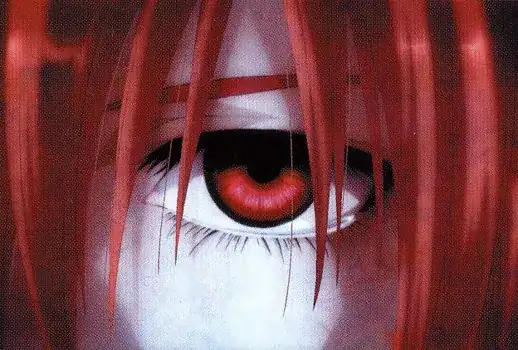
os iusti meditabitur sapientiam et lingua eius loquetur iudicium — Psalmi 36:30
The mouth of the righteous speaketh wisdom, and his tongue talketh of judgment. — Psalms 37:30
As the vocal sets in, we have a zoom out shot of Kaede hugging a mannequin (dummy). A close-up view reveals an uncomfortable suggestion that it is a headless dummy. If you still don't know what to make of the headless dummy, take a look at the surrounding black ravens: they signify death.
Lucy killed Kouta's father and sister, thereby killing his feelings for her. Now, only death awaits her as the armed forces are soon approaching.
In the background, we can see ripe cereals ears, which are ubiquitous in Klimt's artworks presumably as phallic symbols, decorating the Tree of Life. The Tree of Life grows through reproduction and evolution, and bears its fruits, the ravens (deaths), that rest on its branches. Is the human race at the end of one of those branches? Or is it the Diclonius?
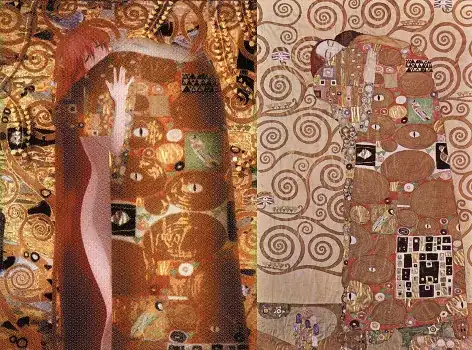
Stoclet Frieze — The Fulfillment (1905)
beatus vir qui suffert temptationem quia cum probatus fuerit accipiet coronam vitae — Iacobi 1:12
Blessed is the man that endureth temptation: for when he is tried, he shall receive the crown of life. — James 1:12
From here on is a flashback to the very beginning of the story of Elfen Lied, when Kaede was first conceived as a child. The first appearance of the title can be seen behind the rustling ripe cereal ears.
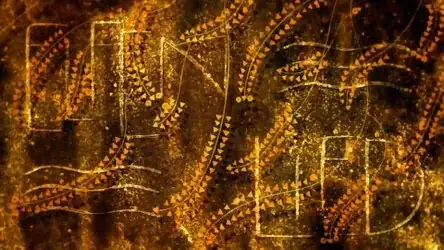
Notice here the horns on the female dummy whom we may identify as Kaede's mother. Despite being a human, she gave birth to the 'Queen' Diclonius and therefore is the true originator of the virus. The mysterious 'blemish' on the mother's abdomen may be tied to a manga-only plot:
After Kaede's mother committed suicide, her abdomen was cut open and her ovaries and womb taken by Chief Kakuzawa.
However, this is not certain as the information was only revealed almost a year after the airing of the last episode of the anime, in Volume 11 of the manga, which was released on August 19, 2005.
The phallic symbols (which almost lit up completely before dimming again) around the private area of both the unconscious Nyu and Lucy, the Eve of the Diclonius race, allude to
Professor Kakuzawa's unsuccessful attempt at raping Lucy/Nyu.
We can make one-to-one correspondences between the females in The Three Ages of Woman and Kaede, Lucy and Nyu. Out of the three, only the cuddling one is making the hand gesture, so she is Kaede, as she is the only one out of the three asking for forgiveness. Then the unconscious one is Nyu, and the facepalming one is Lucy.
Another possibility is that the baby girl is Nyu, the young woman is Lucy, the fertile Queen of the Diclonius, and the old woman is Kaede, who lost her favor with Kouta.
On a related note: Gustav Klimt uses circles, triangles and squares in his artworks, as does the famous Sengai Gibon, who might have had an indirect influence on him because Klimt also studied Japanese art profusely, but I don't have a source to cite for this. Sengai is well-known for his Circle, Triangle, and Square painting, the base of design for the Circle-Triangle-Square Garden at Kenninji, the oldest Zen temple in Kyoto.
In Zen Buddhist philosophy, the Circle, Square and Triangle represent these three elements [ten-chi-jin 天地人] and their relationship to each other: the square signifies Earth, the circle refers to Heaven, and the triangle is man, or the potential of humankind to stand on the Earth and reach toward Heaven – both physically and metaphorically. — Spirit of the Man: Mario Uribe
Sengai left the painting without a title or inscription (save for his signature), however the painting is often called "The Universe" when referred to in English.
While we don't know what Klimt had in mind when he drew those circles, triangles and squares, the workings of the universe do seem to be personified by The Three Ages of Woman and also Nyu, Kaede and Lucy. Isn't it interesting that the Fates also come in threes?
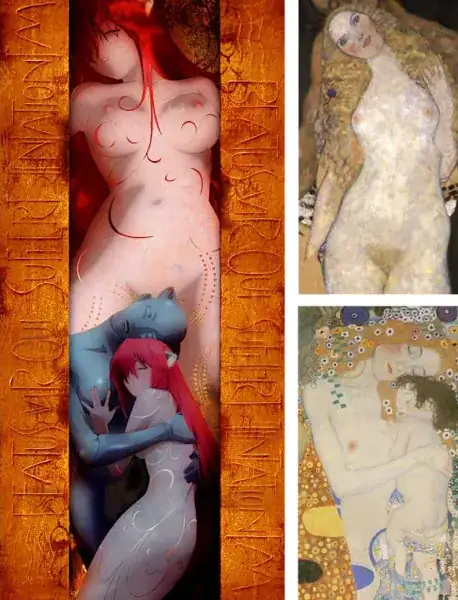
Bottom: The Three Ages of Woman (1905)
Top: Adam and Eve (1917), altered to look also like Medicine (1897) (image)
Then comes an interesting sequence of introductions to three important characters in the series: Yuka, Mayu and Nana, of ages approximately 19, 13 and 7 respectively (according to Wikia). In other words, from elder to younger, from least unfortunate to most unfortunate, and in the order of first appearance in the anime. It is curious to see three females of different ages (adulthood, adolescence and childhood), each getting their own portrait shots, make their appearances in The Three Ages of Woman scene, out of all scenes. Is this incidental or intentional?
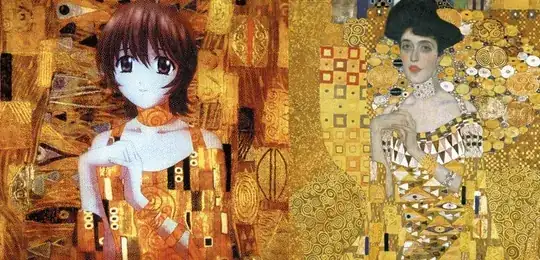
Portrait of Adele Bloch-Bauer I (1907)
The origin for Mayu's portrait is not without much contention. It had been suggested to be Lady with Fan (1917), Portrait of Ria Munk III (1918) and Portrait of Serena Lederer (1899), but I concur only with the suggestion that is The Girlfriends. The two women, possibly lesbians, in The Girlfriends are close to each other just as Mayu is close to Nana whose portrait appears immediately after hers. The fact that Mayu prefers to be with girls lends more evidence to Mayu's artwork being based on The Girlfriends. However, instead of a naked Nana, we have the recurring phallic symbols in the background, which tell us some backgrounds about Mayu:
She was subject to rape and sodomy by her stepfather.
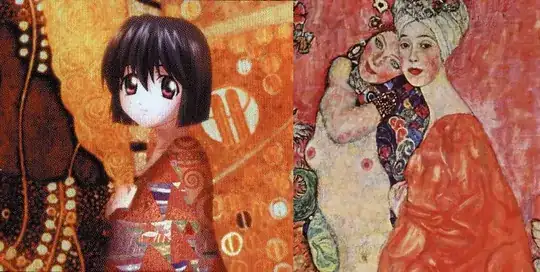
The Girlfriends (1916)
Mäda Primavesi was, by her own account, an independent, assertive young girl, qualities amply captured in this portrait of her at about nine years old. — The Metropolitan Museum of Art
The age and personality of Mäda Primavesi indeed fit Nana's. It is the director's sympathetic portrait of a very real and willful little girl.
The lyrics sung just before Yuka's portrait, "beatus vir qui (blessed is the man)", refers to her good luck, while the lyrics before Mayu's and Nana's, "suffert temptationem (that endures temptation)", signals the pass in Mayu's and Nana's life challenges and in their resisting the temptation to give up and die.
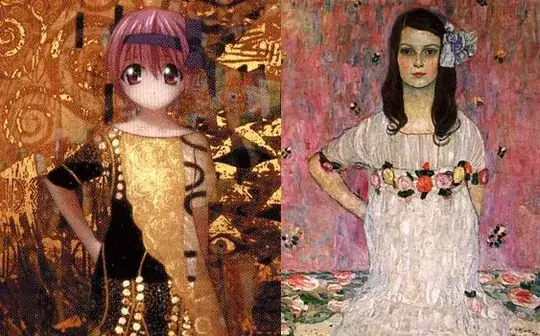
Portrait of Mäda Primavesi (1912)
kyrie ignis divine eleison — ΚΑΤΑ ΜΑΤΘΑΙΟΝ 20:30–31
O Lord, Fire Divine, have mercy on us. — Matthew 20:30–31
Kyrie eleison is a common name of an important prayer of Christian liturgy. The "ignis divine (Fire Divine)" line is added as a trope because "kyrie eleison" is too short.
A specialized use [of a trope] is the medieval amplification of texts from the liturgy, such as in the Kyrie Eleison (Kyrie, / magnae Deus potentia, / liberator hominis, / transgressoris mandati, / eleison).
The prolonged singing of a single syllable of text while moving between several different notes in succession is called melisma. As a side note, quoniam is used in the song in favor of quia because it means the same and sounds better.
This is the only artwork with moving characters: Kouta turns his face away from the viewer and kisses a dummy. Take notice of the human-like dummy Kouta is kissing: judging by her height and bust size, she is around 10 years old, clearly someone from his childhood memories. Is she child Yuka? Or is she child Kaede whom child Kouta treated as a human being?
The third and last scene of Kaede forgoing the hand gesture, and this time she is Kaede herself, not Lucy or Nyu. Ironically, Kaede finds her own fulfillment (not) in the event of The Fulfillment where she still had the hand gesture and where Lucy fulfilled her own desire and duty to kill humans, but in that of The Kiss. You could imagine the dummy kissing Kaede is God or the hypothetical Kouta who loves her / would have loved her in a different universe.
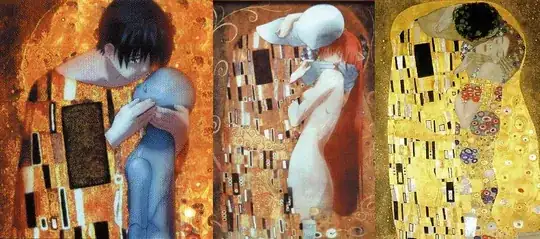
The Kiss (1908)
Kaede's realization that Kouta had cheated on her by going out with Yuka drove her into a deep pit of sadness and madness.
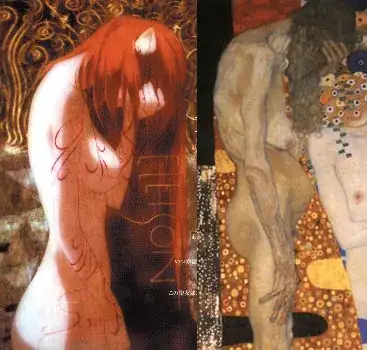
The Three Ages of Woman (1905)
Fire Divine! Kaede was engulfed in a burning rage for revenge! The background is the same as Mayu's. This scene, the only other that looks like the one where the title is first shown, also marks the end of the flashback.
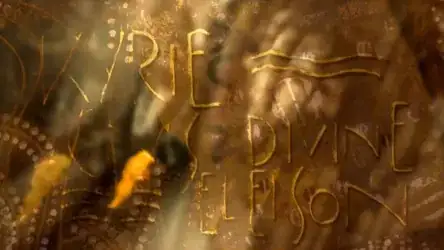
This and the first scene (tear drops) are the only two non-filler scenes without any known reference to an artwork. The two scenes both serve as section stops (almost perfectly at the 0:00 and 1:00 marks in the 1:30 long OP) that fade to black in similar ways, and therefore this is the end of the story of Elfen Lied.
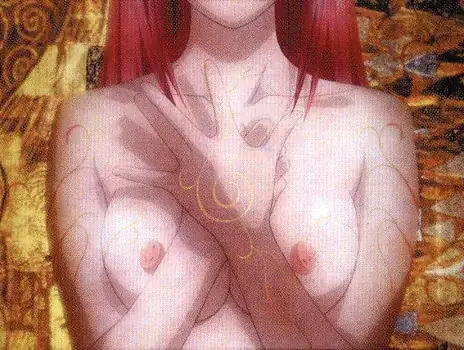
Oh, quam sancta, quam serena, quam benigna, quam amoena! Oh, castitatis lilium.
O how holy, how serene, how kind, how pleasant! O, lily of chastity.
— Ave Mundi Spes Maria
From here on, the scenes are all about depicting Elfen Lied the work. The lyrics in this last section may also be a praise of the series.
Originally, Klimt named his work Water Serpents I as a pretext to show the feminine body in an erotic context without fearing censorship. The anime is certainly challenging and pushing the boundaries of censorship with its gore and nudity.
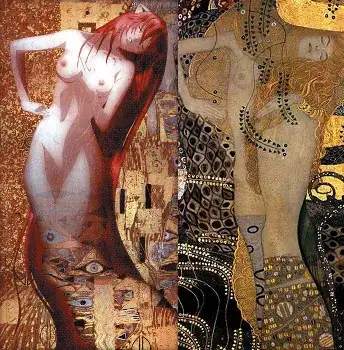
Water Serpents I (1904)
The last scene may have borrowed ideas from Water Serpents II (1904), but ultimately this is just a 90 degree rotation of The Fulfillment, with a slight change in Kaede's head and hands.
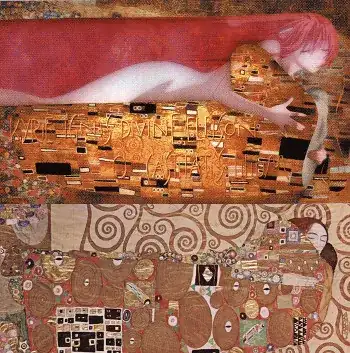
Stoclet Frieze — The Fulfillment (1905), altered to look like Water Serpents II (1904)
If you count the number of unique dummies that have appeared in the OP, and the number of artworks referenced or the number of appearances of Kaede, Lucy and Nyu, you get these numbers.
Walter De Maria once said,
"Every good work should have at least ten meanings."
In this regard, Elfen Lied is a good work of art.












